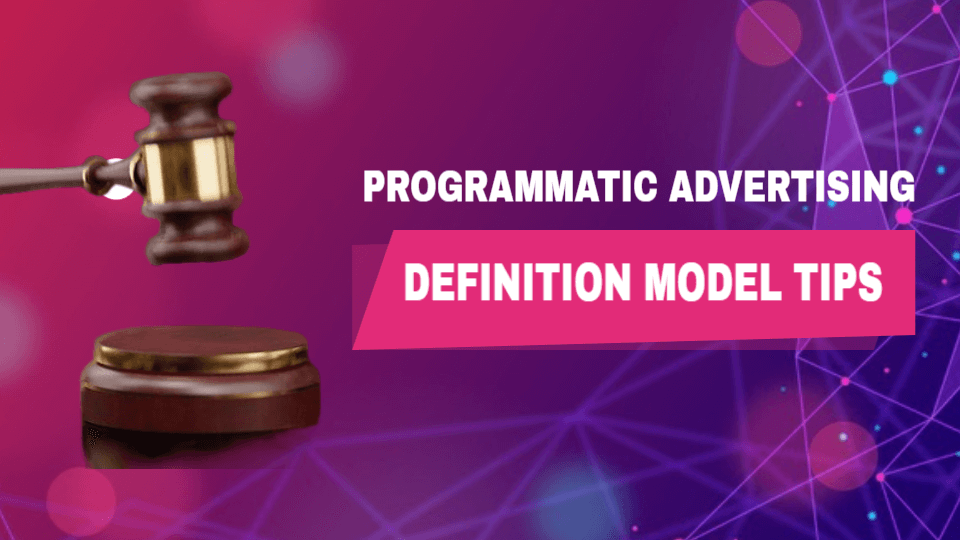8 New Hot Tips on Programmatic Advertising
I am going to share with you the 8 new hot tips on Programmatic Advertising and how you can use them to meet your objectives. Dinet Comms creates programmatic advertising campaigns that automate the process of buying and selling ad space. This model is designed to make the process more efficient and deliver better results for both advertisers and publishers. So what is programmatic advertising? Programmatic Advertising is the adoption of a model that serves ads at the right time and place and at the right price targeting the right audience with efficiency and transparency.
There are four key elements of Programmatic Advertising Business Model. These are the Advertisers, Ad inventory, Ad exchange, and Ad platform. The Advertisers are the businesses or organizations that want to display ads on websites. They purchase ad space through an ad exchange. The Ad inventory is the space on a website that is available for ads. This space is typically sold by publishers. An ad exchange is a marketplace where advertisers and publishers can buy and sell ad space. Ad exchanges use programmatic technology to automate the process of buying and selling ad space. Ad platforms are software solutions that help advertisers manage their campaigns and track their results. Ad platforms typically provide tools for targeting, bidding, and reporting. Programmatic Advertising Business Model is designed to help advertisers and publishers optimize their campaigns through efficiency and transparency to improve their results. In 2016, Programmatic advertising is used by 62 % of marketers to achieve brand goals. The 8 new hot tips of Programmatic Advertising Business Model will now be discussed under the following headings:
* The History of Programmatic Advertising
* Five Programmatic Advertising Myths Debunked
* What is the Programmatic Advertising Business Model?
* Programmatic Advertising Strategy
* The Benefits of Programmatic Advertising
* The Future of Programmatic Advertising
* Case Studies: Successful Programmatic Advertising Campaigns
* Glossary of Programmatic Advertising
* Conclusion

The History of Programmatic Advertising
The history of programmatic advertising can be traced back to the early days of online advertising. Programmatic is an automated way of buying and selling ad space in real-time, using algorithms to determine which ad to show, when, and where. It allows for more targeted and effective advertising, as well as increased transparency and efficiency in the ad buying process. Programmatic advertising has come a long way since its humble beginnings and is now responsible for a large majority of digital ad spending. In 2017, programmatic ad spend was expected to reach $32.56 billion, representing 82% of all digital display ad spend in the US. This rapid growth is due to the many benefits of programmatic advertising, which we will explore in this blog post.
Five Programmatic Advertising Myths Debunked
As the digital landscape continues to evolve, so does the world of programmatic advertising. Ten years ago, programmatic was a hot new buzzword and people were only just beginning to understand how it worked. Today, programmatic is a well-established and integral part of the digital advertising ecosystem. However, there are still many myths and misconceptions about programmatic advertising. We will debunk 10 of the most common myths about programmatic advertising. After reading this, you will have a better understanding of how programmatic works and how it can be used to achieve your marketing goals.
* Real-time bidding (RTB) and Programmatic Advertising are the same
No, this is not true in the media-buying digital world. Programmatic Advertising automates ad buying. Real-time bidding (RTB) is a type of programmatic buying. The others are Private Marketplace (PMP) and Programmatic Direct.
* Ad Fraud Eats Deep in Programmatic Advertising
Let’s be frank with ourselves, Ad fraud is an industry problem but in Programmatic Advertising, the participants in the ecosystem have improved the controls to reduce it.
* The Quality of Real-Time Bidding
Where the RTB is acknowledged to be low, the players (SSPs and DPSs) would remove ad inventory from the marketplace.
* The Black Box Label
In a situation where a programmatic company is labeled a black box, you can switch to partners who promote transparency with better tools for reporting and tracking.
* The Algorithm Challenge
The algorithm efficiency, over time, would improve to experience long-time insight benefits.
What is the Programmatic Advertising Business Model?
The programmatic advertising business model uses software to automate the buying and placement of ads. This type of advertising allows marketers to target specific audiences with laser precision and to track the results of their campaigns in real-time. Programmatic advertising is the future of digital marketing, and it is already revolutionizing the way that brands reach their customers. Programmatic ad buying has been divided into three categories namely Real-Time Bidding (RTB). Private Marketplace (PMP) and the Programmatic Direct.
- Real-Time Bidding (RTB): This is an open auction where ad inventory prices are decided in real-time. The auction is open to both, the Advertiser and Publisher with cost-efficiency attraction when buying for a large audience.
- Private Marketplace (PMP): This is another open auction but restricted to select invite-only advertisers or those that have applied and followed a selection process.
- Programmatic Direct: Under this procedure, the publisher bypasses the auction method and sells ad inventory at a fixed price per mile (CPM) to advertisers.
The programmatic advertising ecosystem under which the above operates is the Supplier-Side Platform (SSP), Demand-Side Platform (DSP), and Ad Exchange.
- Supplier-Side Platform (SSP): This app is used by the publishers to sell display, mobile and video ad impressions to potential buyers (ad exchanges, networks, and DSPs) automatically in real-time and gives them control of inventory and cost per mile impressions.
- Demand-Side Platform (DSP): This app enables agencies and advertisers to buy ad inventory across platforms.
- Ad Exchange: This is where the SSP feeds ad inventory into the Ad Exchange. In turn, The DSP connects to the Ad exchange that enables the advertisers, agencies, networks, and publishers to buy and sell ad space at agreed inventory prices through the bidding process. Advertisers and agencies buy ad inventory in a real-time auction to target the right audience at the right place and at the right time with guaranteed speed and efficiency.

Programmatic Advertising Strategy
As the world of advertising continues to change and evolve, so too must the strategies that advertisers use to reach their target audiences. Programmatic advertising is a type of advertising that uses data and technology to automate the buying and placement of ads. While programmatic advertising can provide reach and scale, it’s important to remember that it’s not a one-type-fits-all solution. In order to create a successful programmatic advertising strategy, you need to have a clear understanding of your target audience, your objectives, and the platforms available to you. With that in mind, let’s take a look at a few key tips for developing a successful programmatic advertising strategy.
- Situational Analysis
- Target Audience
- Creation of Engaging Ads
- Channel Selection and Placement
- KPIs
- Conclusion
Situational Analysis
Where are we? Let’s do a swot analysis of the current position of a brand in relation to the competition to have a clearer vision of the strategic direction we should go to achieve the desired goals given the position of the resources available. Thereafter, we set smart goals, for example
- Sales Increase
- Step up the Brand Awareness
- More traffic and Leads
- Reduction in cost per acquisition of customer
- Increase Retargeting Efforts and
- Goals Measurement Accuracy
Data Selection in Relation to the Target Audience
One of the importance of a programmatic advertising strategy is the use of accurate data to target the audience at the place and at the right time eliminating wastage with greater efficiency and transparency. Segment the target audience analysis obtained from the data management platform – SSPs based on demographics, psycho-graphics, etc. having mapped the customer journey around the lifecycle marketing experience to achieve the set goals.
Creation of Engaging Ads
Create high-converting visual content for the select media channels.
Channel Selection and Placement
Run a programmatic advertising campaign using a select mix of media channels such as display ads, Mobile ads, Video ads, Native ads, OTT/CTV ads, Interstitials ads, and push notifications in burst or continuous patterns with the approved budget to achieve the goals set.
KPIs
Use the KPIs to know how far, the campaign has fulfilled the goals set.
The Benefits of Programmatic Advertising
Programmatic advertising is a type of advertising that uses automated computer systems to place ads on websites. This type of advertising allows advertisers to target specific audiences with laser precision and to achieve a high degree of ad visibility at a lower cost than traditional methods. With the advent of programmatic advertising, online advertising has become more complex and sophisticated. As advertisers seek to maximize the efficiency and effectiveness of their ad campaigns, they are increasingly turning to programmatic ad buying. Benefits of programmatic advertising include the ability to target specific audiences, increase ad visibility, and improve ad campaign efficiency. However, programmatic advertising also has its challenges, such as the potential for fraud and the need for specialized knowledge. As programmatic advertising continues to grow in popularity, it is important for advertisers to understand the benefits and challenges of this type of advertising. By understanding the pros and cons of programmatic advertising, advertisers can make more informed decisions about whether or not this type of advertising is right for their business.
Conclusion
Programmatic advertising is an important aspect of digital marketing, and understanding the definition and model can help businesses succeed. By adopting a programmatic advertising definition model, businesses can buy ad inventory in real-time, using automated technology to serve ads at the right time, targeting the right audience. Contact us now for your next programmatic advertising campaign. Let’s talk.
Published July 18 2022 by Adebola Adeola CEO Dinet Comms
- Programmatic Advertising Advantages, Programmatic Advertising Agency, Programmatic Advertising Analytics, Programmatic Advertising Audience Segments, Programmatic Advertising Campaigns, Programmatic Advertising Case Study, Programmatic Advertising Challenges, Programmatic Advertising Ecosystem, Programmatic Advertising Examples, Programmatic Advertising Exchanges, Programmatic Advertising Explained, Programmatic Advertising In Digital Marketing, Programmatic Advertising Industry, Programmatic Advertising Online Meaning, Programmatic Advertising Open Auction, Programmatic Advertising Open Exchange, Programmatic Advertising Optimization, Programmatic Advertising Overview, Programmatic Advertising Skills, Programmatic Advertising Specialist, Programmatic Advertising Statistics, Programmatic Advertising Strategy, Programmatic Advertising Targeting, Programmatic Advertising Technology, Programmatic Advertising Terms, Programmatic Advertising Tools, Programmatic Advertising Trends, Programmatic Advertising Trends 2021, Programmatic Advertising Trends 2022, Programmatic Advertising Types, Programmatic Advertising Usage, Programmatic Advertising What Is It, Programmatic Advertising Workflow, Understanding Programmatic Advertising
About us and this blog
We are a digital marketing company with a focus on helping our customers achieve great results across several key areas.
Request a free quote
We offer professional SEO services that help websites increase their organic search score drastically in order to compete for the highest rankings even when it comes to highly competitive keywords.
Subscribe to our newsletter!
More from our blog
See all postsRecent Posts
- Developing Web Applications for Niche Markets February 27, 2023
- Martial Arts! Discover 361 Best Training Camps October 17, 2022
- Surf Camp! Discover the Finest 500+ Surf Spots October 7, 2022





